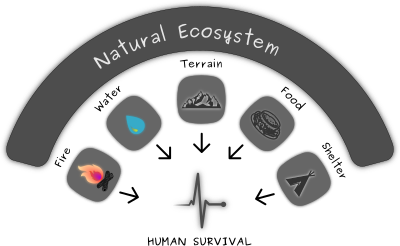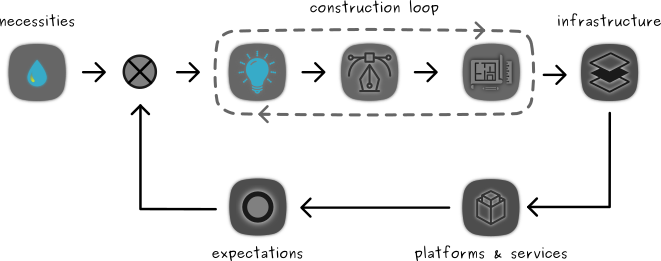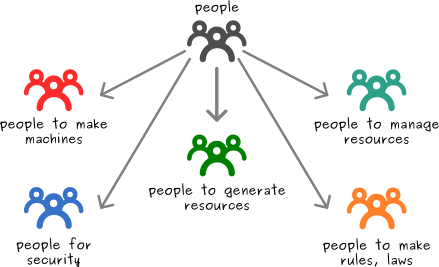DISCLAIMER :
Whatever i say here is not at all new, and everything is out there in Internet, and one can find great communities who are working for years. Sometimes, might be wrong, and i welcome readers to correct me wherever possible. I have kind of collated or summarized about what i have learned till now. Thus it is almost my knowledge mirror about the field or concept - which means the content is subjective to change. Beware the post might be too abstract & sometimes goes philosophical.
We unlearn to learn & thus we need to learn to unlearn.
@ /.\ ----+--------------------------+/ \ | Do you think that people | | will hear you ? | +--------------------------+ +---------------------+-- ( me ) | Why should i care ? | +---------------------+ +-------------------------+------ ( me ) | I like to share, they | | must analyze themselves | | & take decisions ! | +-------------------------+
WHAT IS INFRASTRUCTURE ?
Infrastructure is reality. It is the real stuff which we depend on to live daily. It is the collective reflection of our survival capability. We humans are basically animals. Are we social beings ?.. well i dont know yet ! However, we have been changing our infrastructure by displacing ourselves since our inception, and then we tried to change the infrastructure using our intellectual curiosity, that led explore and discover stuff to understand a wider scope, which in turn provide us with information about the required infrastructure for our survival that can provide us with expected features & facilities.

Now for a stable survival, we expect a fundamanetal infrastructure which is deterministically stronger and immune to disruptive changes. To start we designed the architectures that are necessary to build these infrastructures that we expect. Thus infrastructure is now the implementation of the architecture where our expectations are embedded in its design. right ?

To obtain stability in survival, we have formed commonly agreed laws, policies, rules, that are not deterimental to liberty of the people, but only sufficient enough to regulate and maintain the loops consistently to enable a constant flow of resources. After establishing a stable infrastructure, the routine or loop is executed on timely patterned manner with duty cycle, to transform the natural resources into goods and consumable fuel that are necessary to sustain the operation of the infrastructure. We live over this abstracted and isolation providing infrastructures that helped us to expand our curiosity, exploration, giving rise to new expectations that updates or replaces the existing necessities. These expectations are then termed as new necessities and the whole process is followed once again, to update the current one or create another infrastructure that satisfies the new expectation.

IS IT NECESSARY ?
Survival strategies, Design, Architecture, Organization, & Infrastructure are all part of the process. One could not isolate just one of them and discuss about it alone. We live our lives on the infrastructures which are obvious but, some would only recognize only after mentioning it. For instance :
- Time ( think about it )
- Food Production & Distribution
- Communications
- Transport & Logistics
- Governance
- ....
No matter how much abstract we could go about infrastructures, end of the day they all depend upon the Physical resources. It is with the technology in hand we transport all these resources available in the environment and transform into inputs and outputs of several infrastructures & some times we make infrastructures using them recursively.


Transforming resources into supplies is hard work and we do it, because the method has proved to provide us with stable survival strategy. This has recursively enabled us, to save more time that let us think and contemplate our curiosities without any fear of survival. Thus with more and more free time, feautres, services we yield from the current infrastructure, we tend to do it indefinetely by erecting loops & treadmills that does and maintains this cycle constantly. We want it to be constant. Thus one part of the people in the society would naturally be subjugated, deprived liberty, emotionally motivated to serve this purpose, so that the remaining part would follow their curiosity. With growing population, everyone wants to migrate to the interesting side of the offer, which is regulated using competition, prerequisite & qualitification strategies. Who are these loopy people who enables the cycles, for exmaple ?
- farmers
- miners
- bureaucratic workers
- security providers
- ...
WHAT'S THE PROBLEM ?
Well, the people who constructs the infrastructure using some basic design of architecture, tend to end up bifurcated or multifurcated, just to serve back the infrastructure itself. Now, the terrible question is, whether these humans end up serving the infrastructure or the other way round which was originally envisoned ? While it is not fair to divide and privelege people by themselves to enjoy the fruits while the remaining toil !. Moreover, with time, our dependency on these centralized structures become more and more intimate and tight, to a point where distinction between the structure and the people is no more recognizable.

All these conditions are emergent, and originally it might never be intended to reach a state like this at all. This situation provides us with the following three options :
- flow along the system's infrastructures path
- stop & think of tinkering, fix it through updates
- think of alternative designs, architectures proposing a new structure
With these systems, loops, treadmills, infrastructures in place, and year after year people depend on it for their livelihood, simply tends to believe that it is with the infrastructure they can sustain their life. Moreover, they firmly believe that without these infrastructures, life is not possible. This dependency indicator is a clear measure of ignorance, and infrastructure's creepy control over one's life. In first place, we have innovated methods to create these infrastructures to let us think freely, while the emergent situation seems to indicate a diametrically opposite status.
As illustrated in the fig.5, the distance between the stages of the deterministic process increases further and further and tends to extend even more, when the expected comfort zones are more abstract, and at the comfort zone, only the preluding layers operations might be obviously visible, if transparency is provided along with the abstraction. Observation always demands transparency. It is only when this regulating feature is demanded, it will be included in the design, and future implementation makes it easier for observors to gather information, and atleast propose updates, solutions for the problem they prioritized. It does not matter how many eyes are observing, when the operations are fundamentally obscured or manipulated to show simulated reality.
So far one can see, that the following 5 parameters are influential in regulating the infrastructure beasts to keep them in check to bring the balance in power & responsibility :
- distance between process stages
- transparency vs. obscurity
- accountability
- observation vs. isolation
- social auditing vs. authoritative inspection
HOW ITS MADE ?
Every system is derived from network of systems embedded in the architectural design. Initially infrastructures are then constructed to fulfill several necessities, which are again netwoked to form a super infrastructure that depends upon these smaller infrastructure. To keep these systems away from disturbances, the design infuses defensive or oppressive loops in the architecture itself, which will later fight against those disturbances, if they occur. Learning from the past, will help mitigate the known and measured disturbances, and designers will have to design by predicting all possible future disruptions that might occur. This makes the infrastructure live. It recognizes time and depends on time, it now can learn from the past, could have a intended future, and its going to last as long as people feel contend with it. Furthermore, the implementation (infrastructure) includes humans in the loop to make it work for which it is designed & erected. Thus every system so far we have made were essentially infrastructures - that too highly centralized.

It is no more a system of machines, run by deterministic machines, which can be programmed to execute according to conditions, rather it becomes a sentinel, that can react, respond, defend, or even oppress & attack when it sees fit and necessary. Thus it is upto we humans, to observe it carefully, regulate it, or even change it by updating it or raising completely a new altenative. If most of the people are ignorant, then the weakness in the current infrastructure might be used against itself & the people depending on it. Generally, every human is ignorant, inspite of their power, influence, financial, economic, & social capital. Nobody, can define the limits of ignorance. We all are ignorants. All we do is follow the curiosity, take a leap of faith every now and then, with courage and confidence, and open up the blockades of ignorance - which we call as discovery.
On the other hand, as shown in fig.5, if distance d1, d2, d3, d4 ... are taken in advantage for obscuring the functionality, then it significantly raises induced ignorance among the people. This remarkably increases the weaknesses of the system, which eventually reflects as denial of transparency. When transparency & accountability are denied for the sake of stability, then the infrastructure creeps away from the commonly accepted design & architectural properties. This imbalances the power of control.
It is not only that people gets stressed when new expectations are demanded from the infrastructure, but also the resources which we transform as products for the expectations do become victims of stress. Once if the resources exhausts, we either search for a better resource or look for other locations instead of changing our design patterns and solutions. Even to know that the resources are under stress, the data collected must have a transparent channel to communicate publicly. This simple adaptation, changes the whole regulation process through social auditing.
WHAT IF ?
What will happen, if the infrastructure is experiencing a massing hit emerging internally or externally , that overwhelms its threshold of pain, and loses control ? The following options can be observed from history :
- instead of responding, it might react to the disruption (distress due to fear)
- would defend itself or oppress the disruption/change in extreme
- some times responds, and progressively adapts to fit itself for change
- some times defeated by uprise, and a alternative infrastructure raises
What will happen if the infrastructure, abstracts more and more, to a state where the fundamanetal architecture is not obviously transparent. One cannot refute, it is not transparent, but at the same time cannot comprehend its presence & meaning hindered by the complexities of infrastructure itself. Then there might be a chance that the infrastructure and the features built on top of its platform could use such difficulty - as a loophole to gain which it values as profit. Infrastructure by default derives its power from the people who constructed it and who lives in it. All the platforms built on top of it were again to serve the people in it. With people depending upon the infrastructure, and growing ignorant about its complex orchestration, lose the default transparency and accountability from the erected infrastructure.
DEEPER DIVE !
Hence, we cannot escape the sphere of ignorance, and all we can do is to open it up one by one, little by little, to reach a much wider knowledge. We used to call it as Thinking, Learning, & Educating - hoping us to organize the knowledge we have interpreted, learned & understood. In the process we unlearn a lot of things, and learn lot of things - updating ourselves, our mindsets, our thought process to reach out further. This explains, that we are basically explorers, driven by curiosities. Hierarchy and time influences us a lot more than we actually think of them. They both help us organize information, knowledge and regulate the versions of knowledge, to ease the unlearning & learning process.
With ever expanding knowledge, we really don't seem to change the way we construct our infrastructures, and we always seems to care only about constancy, stability, run for eternity. We even constructed other infrastructures that make the updating process so tedious, which we often point our fingers as a reason for not changing ourselves. Fundamentally it is a question of : "What is the use of so much knowledge, organization, anti-ignorance we have learned, while we let most of us behind to churn out constant supply of survival resources ?"
SO ?
A significant change in the established normative state, that either struggles to adapt the change or refuses to accept the change, can be deserted by the people in a ideas scenario leaving the system empty, with people left in distress who were until now dependent upon the infrastructure for their livelihood. So a social mobilization strategy is required, that can handle the transition, must be in place to gather people, educate, and make them realize the adverse effects of present system, how to rectify it, to start think for alternatives and so on.... To make this work, the underlying architecture has to be redesigned with one of the following strategies:
- update one stuff at a time
- design different alternatives

The above illustrated strategies can even be mixed, to decide on a particular alternative, and to use time to update the current systems architecture one step at a time, by deconstructing it from the initial version and slowly reconstructing it aligning towards the critically reviewed alternative. This adds the advantage to reach out to the public, make them aware by propagating the flaws, loopholes, unnecessary complexities, in the system. One has to observe that the initial version might be a corrupted version of a originally neutral version.
i.e, initial version != origin version
Thus it also facilitates to reset the systems nature and functionality to the default case, while adding the necessary updates required to attack the corruption or creep which previously infected the systems functionality and operation. Compare whether the new ideas/architectures & design address the limitations in the earlier system and solves them, or does it empowers only the existing advantages. Address limitations alone, or empowering advantages alone is not a balanced functionality and will most likely end in detrimental operation sooner than expected, as the new update or new design favours a partial view of the system without ever properly understanding it. Even in a collaborative effort, care has to be taken to see that this does not occur as far as possible.
As you might have already recognized, i have just imitated this strategy from a distributed software revision control system.
ANSWERS ?
It depends on :
- how much we keep informed ourselves, through independency ?
- how much clarity in analysis we reach ?
- what actions we take to keep the systems in check for transparency & accountability ?
- what actions we take to keep the systems, networks, infrastructure, architectures lean & mean ?
- how we are going to participate in governance ?
- how much power & responsibility we are going to transform to a central control ?
- how much deliberate, critical, conscious of : asymmetry, unjust laws ?
- how we maintain the transparency of mechanisms ? who controls the policies ?
- how we are going to be collaboratively united ?
- who owns the infrastructures, who observes the checks & balances ?
- what strategies we use to regulate organizational clarity ?
We have stayed contend with the stable survival loops instead of thinking about flexible sustenance ideas & strategies. We are not here to just survive. We are here to live, and live with liberty. Instead of designing architectures with stability and security alone, they have to be innovated with flexibility and adaptibility. This would make the infrastructures adaptive to changes, while not pushing the people towards a ignorant territory, but embraces them along with the change. If there is a fundamental design or architectural flaw, they need to be addressed instead of patching the effects through obscurity.
Will the infrastructures become adaptible if they are owned by the commons, like commons land, commons governance, commons communication networks, commons transport networks, commons food & farming networks... ? that requires wider & deeper critical thinking. We are not sure about anything, but atleast it does not harms us to try those strategies for building up some of the current infrastructures in a commons design point of view.
WHAT'S THE POINT ?
There might be no point in me writing this, or you reading this. In fact, this writeup may not make any sense to you at all. If it makes some sense, then i believe that it might provide you with some questions to think about or at best, drives you to try to think about some alternative ideas & solutions.






